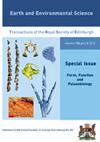Proposal of the colour pattern reconstruction of basal cervids
IF 1.2
4区 地球科学
Q4 GEOSCIENCES, MULTIDISCIPLINARY
Earth and Environmental Science Transactions of the Royal Society of Edinburgh
Pub Date : 2023-03-02
DOI:10.1017/s1755691023000026
引用次数: 1
Abstract
Methodologies that analyse the colouration and external appearance of extant species are very useful tools when facing one of the greatest challenges in the palaeoartistic reconstructions of extinct fauna: inferring the colour patterns. Earlier works have applied this methodology, for example, in the reconstruction of the Miocene bovid Tethytragus, proving that the maximum likelihood (ML) analysis to infer ancestral states has promising potential. This study offers a proposal for the reconstruction of the external appearance of Heteroprox moralesi Azanza 1989, an early cervid of the Middle Miocene present in several fossil sites of Central Spain. For the reconstruction of the external appearance, the colour patterns of all the extant species of the family Cervidae were studied with the method of ML analysis, as well as recent works about their phylogeny. The results show the most probable basal colour pattern of the cervids: dark shades on the limbs, dorsal section, and head of the animal, and, in contrast, lighter colours on the neck and perianal region. This basal pattern can be used as a basis for reconstructing colouration and to hypothesise about the external appearance of extinct taxa. Furthermore, the inferred forest habitat of H. moralesi has been taken into consideration in order to adjust the colour pattern, comparing the final results of the analysis performed in this study with that of the pattern observed in extant forest deer as well as with previous works employing this methodology.基底颈动脉彩色图案重建的建议
分析现存物种的颜色和外观的方法是非常有用的工具,当面临灭绝动物群古艺术重建的最大挑战之一:推断颜色模式时。早期的工作已经将这种方法应用于重建中新世牛Tethytragus,证明了推断祖先状态的最大似然(ML)分析具有很好的潜力。这项研究为重建1989年中新世早期鹿的外观提供了建议,该鹿存在于西班牙中部的几个化石遗址中。为了重建外部外观,用ML分析的方法研究了鹿科所有现存物种的颜色模式,以及关于它们的系统发育的最新工作。结果显示了鹿最可能的基本颜色模式:动物的四肢、背部和头部呈深色,相比之下,颈部和肛周区域呈浅色。这种基本模式可以作为重建着色的基础,并假设灭绝类群的外观。此外,为了调整颜色模式,还考虑了推断的H.moralesi的森林栖息地,将本研究中进行的分析的最终结果与在现存森林鹿中观察到的模式以及之前使用该方法的工作进行了比较。
本文章由计算机程序翻译,如有差异,请以英文原文为准。
求助全文
约1分钟内获得全文
求助全文
来源期刊
CiteScore
2.00
自引率
0.00%
发文量
21
期刊介绍:
Earth and Environmental Science Transactions (formerly Transactions of the Royal Society of Edinburgh: Earth Sciences) is a general earth sciences journal publishing a comprehensive selection of substantial peer-reviewed research papers, reviews and short communications of international standard across the broad spectrum of the Earth and its surface environments. The journal prides itself on the quality of its graphics and photographic reproduction. The Editors are keen to encourage interdisciplinary papers and Transactions also publishes occasional special symposia and invited volumes of specific interest.
We are currently in the process of digitising the archive of RSE Publications, and the archive of the Transactions, dating back to 1788, will be available from the back issues link on this site.

 求助内容:
求助内容: 应助结果提醒方式:
应助结果提醒方式:


